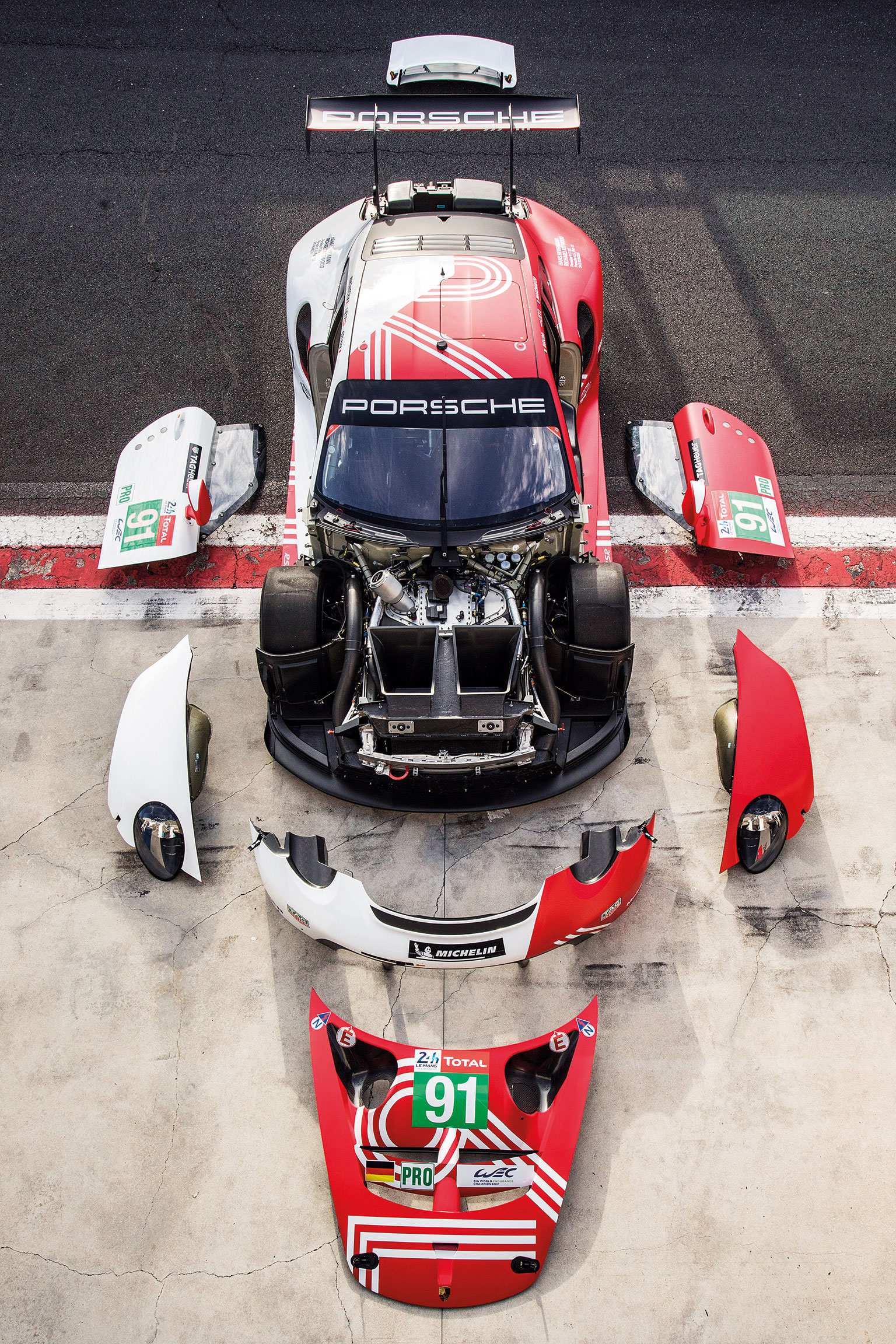What Lies Beneath
The 911 RSR story began in the mid-70s but this is the latest chapter. As Andrew Frankel discovers, the ‘95% new’ RSR-19 has little in common with its ancestors
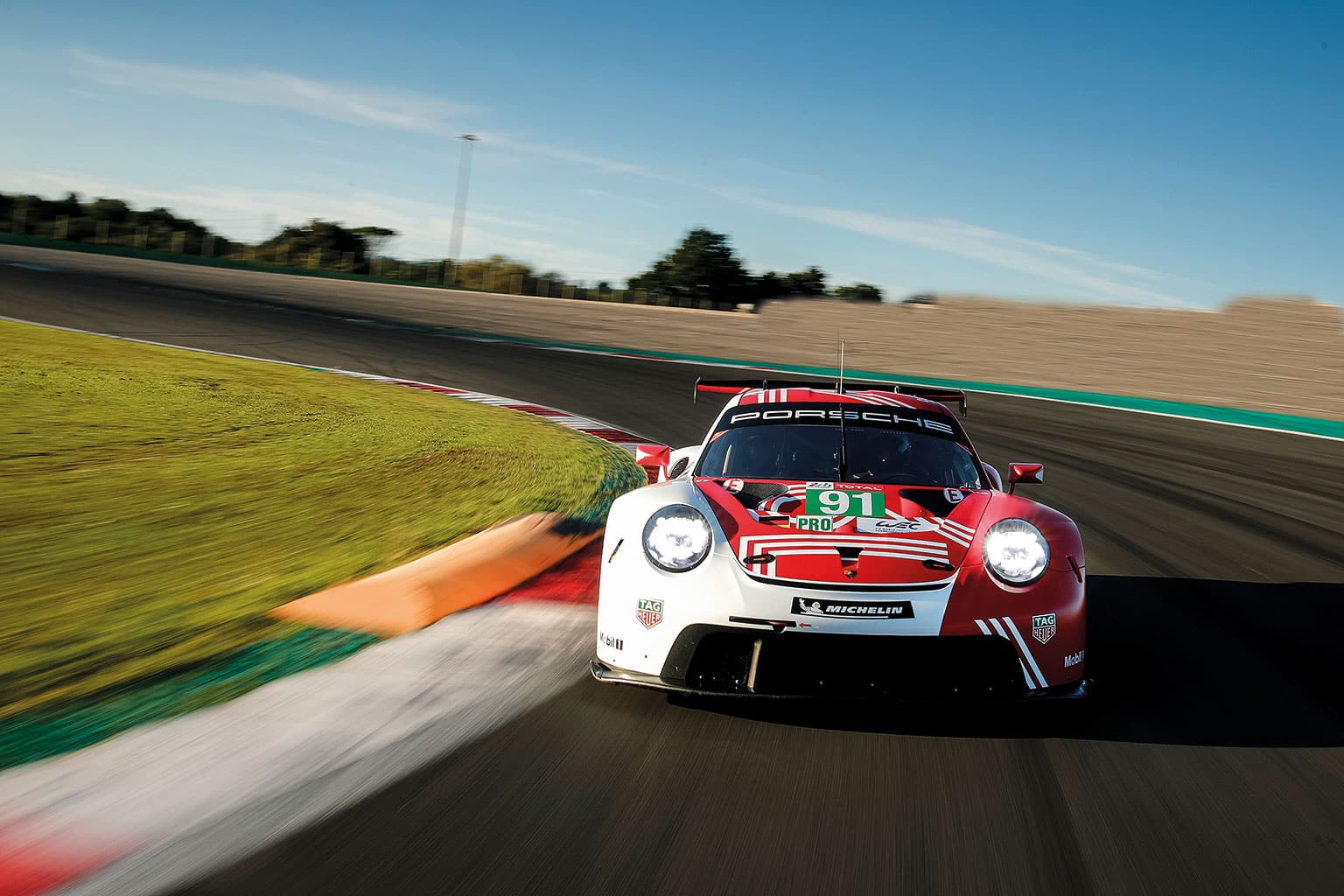
If you want to know how far removed from even the raciest street-legal Porsche is this 911 RSR-19 – its current Le Mans and World Endurance Championship contender – you don’t need to drive it, though I have. You don’t even need to pore over its specification, nor crawl all over it, though I did. All you really need to do is ask Porsche’s head of WEC operations Alex Stehlig a simple question.
“If I gave you a new road 911 and asked you to turn it into an RSR…” And that’s as far as you get before Stehlig looks at you as if you’ve parted company with your senses. “You couldn’t,” he says, wide-eyed at the thought.
Try from the other direction. “Okay, could you show me round the car and point out those components that have come from the road car?” Alex pauses, now lost in thought, before he smiles as an answer pops into his head. “Here!” he says pointing to the rear lights.
“So the RSR has the same rear lights as a road 911?”
“The lights? No. Just the plastic covers.”
“Anything else?”
Alex walks to the other end of the car and points at the Porsche sticker that passes for a badge on the bonnet. “That,” he says. “Maybe.”
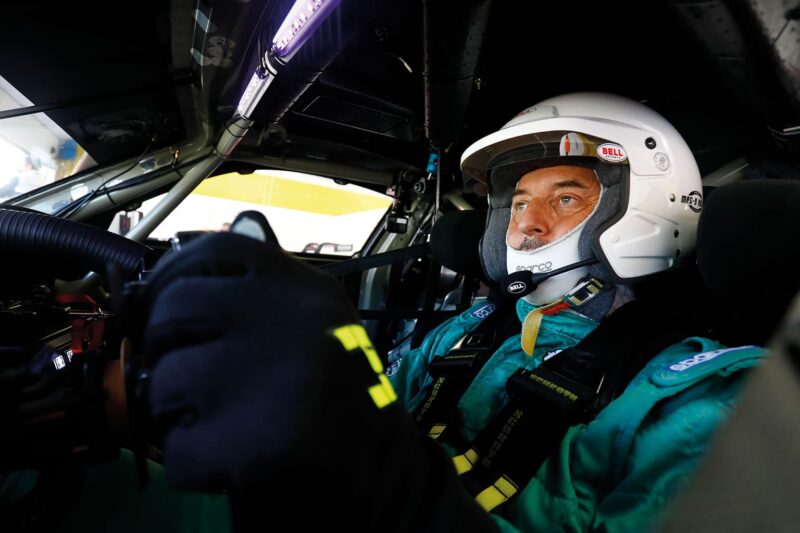
Earplugs, balaclava, helmet and sound-absorbent fabric still can’t fully hide the din of the RSR-19
So though it looks like a Porsche 911, is powered by a flat-six engine and is made by the same people who make the Porsche 911, I’ll leave it to you to decide whether it really is a 911. It doesn’t even possess that other unmistakeable 911 hallmark: a rear-mounted engine. Because the 911 road car uses a version of the platform also employed by the mid-engined Boxster and Cayman, in 2017 Porsche argued that it should be allowed to turn the engine and gearbox by 180 degrees, creating the first mid-engined 911. Some salivated over the prospect of a mid-engined 911 road car. Three years later, they’re still salivating.
But this car, though it is mid-engined, is not that car, the RSR-17. This is the RSR-19, Porsche’s current top-line racer, barely a year old and the car that secured pole position at Le Mans before, for reasons still not yet fully understood, its race fell apart. Porsche says 95% of its components are new – not relative to the street 911, but the previous RSR. It is the most evolved and sophisticated road-derived sports racing car ever produced by the most successful manufacturer of sports racing cars.
And yet at first acquaintance, it does not seem that way. Porsche has just dispatched 10 RSRs to customer teams who paid £860,000 for each one, comfortably more than double what it charges for a GT3 category 911. Then again, you can’t race a GT3 at Le Mans.
Where is the money going? Sure, its engine has 4.2 litres instead of the 4 litres offered by its closest road relative, the GT3 RS, but with around 515bhp it’s got a lower specific output. It could be tuned to provide far more power, but it would be pegged back when Balance of Performance countermeasures were applied. It has a six-speed paddle-shift gearbox, where the road car has seven, and steel brakes in place of its cousin’s optional carbon ceramic units.
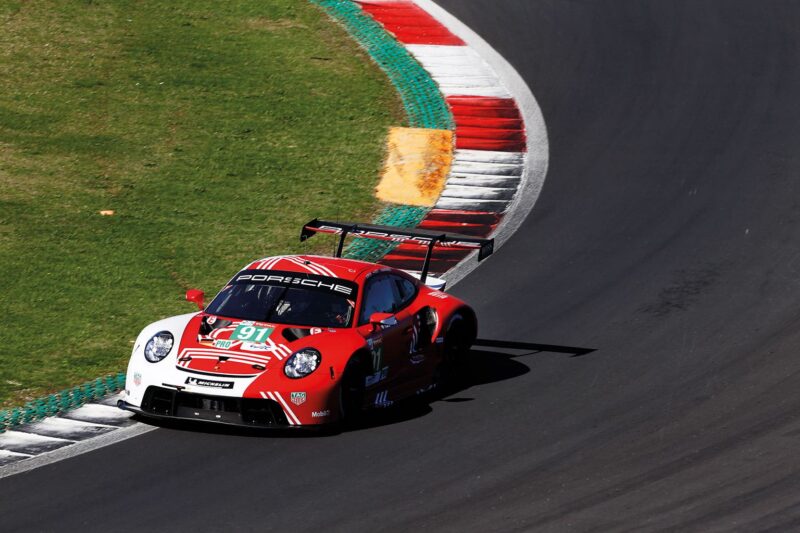
A few laps in, Frankel was getting the hang of its handling; it’s something else
Once more you find yourself being asked to look at it from the other direction, the Porsche Motorsport direction. There’s no need to ask how Porsche defines this car because it’s there on the crib sheet they give you: “A single-seat race car for the FIA GTE category”. It’s not a 911 adapted for racing, it’s a single-seater obliged by regulations and Porsche’s marketing it to look like a 911.
Every bit of bodywork you can see is carbon-fibre. The aero package is monstrous, from the huge splitter and gaping mouth at the front to the rear wing and its savage-looking diffuser. It is that diffuser, and not the fact that mid-engined cars are better balanced, that drove the decision to push the motor ahead of the rear axle line. When Ferry and Butzi were configuring the car that would become the 911 in the early 1960s, the future inconvenience of siting the engine where a diffuser should sit would not have delayed their deliberations.
We are at Vallelunga and the first thing that happens is I am invited for a fitting. There is no requirement for the interior to look like a 911, so the pretence is dropped. It’s a flightdeck. The only thing I can find that might have come from a 911 is the twiddler for the wing mirrors.
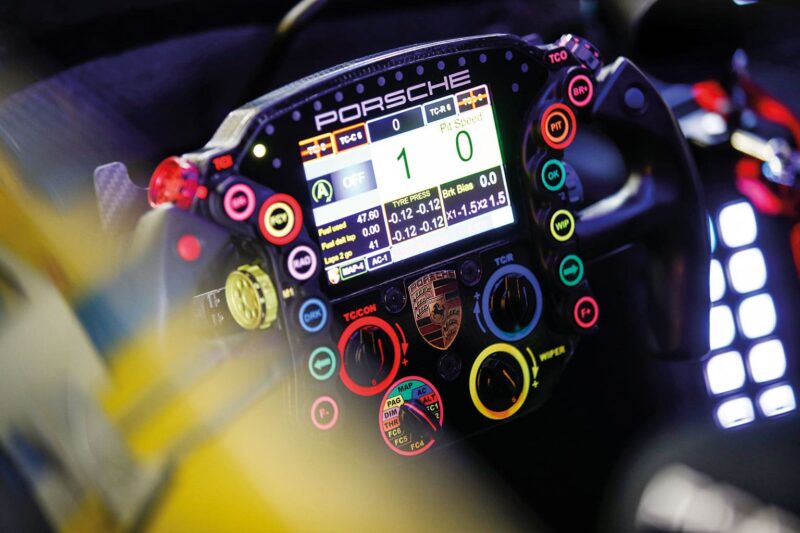
The flightdeck of the 911 RSR
Getting in is undignified for a man of my size and the seat is uncomfortable because it’s designed for the slim-hipped Gianmaria Bruni, who took pole at Le Mans in what he tells me is this very car. But you forget all that quickly. The seat is fixed in position and air-conditioned, which I’ve not come across in a racing car before. The pedals slide forward and the steering column has a luxurious range of adjustment. The wheel has a Cosworth central display and data logger and, arranged around it, 30 separate controls which, as Porsche observes, is 30 more than they had a couple of decades back. It’s so bewildering I’ve been provided with an idiot’s guide map, pointing out those controls I’m likely to need, which is hardly any. Indicators, pitlane speed limiter, fast start buttons and that’s it.
It’s about now, when you’re settled in the car, waiting for the signal to go, that a small punch up that’s been brewing for a while breaks out between your ears. The logical side of your brain has rationalised this. I don’t know the circuit well but a couple of laps in a 911 road car didn’t reveal many horrors. Simple maths demonstrate the RSR will be rapid in a straight line but unlikely to tear my head off. Truth is I’ve driven plenty that are faster. And it’s even got traction control, which should save me from myself should I tread too hard at the apex and overdose its enormous Michelin slicks. But the other side of my brain is making far more noise. “Just look at the bloody thing,” is one observation. “Have you heard it?” is another. I have, which is why Porsche insists that in addition to earplugs, a balaclava and helmet, they also tape sound-absorbent material over your ears. Which is a first for me.
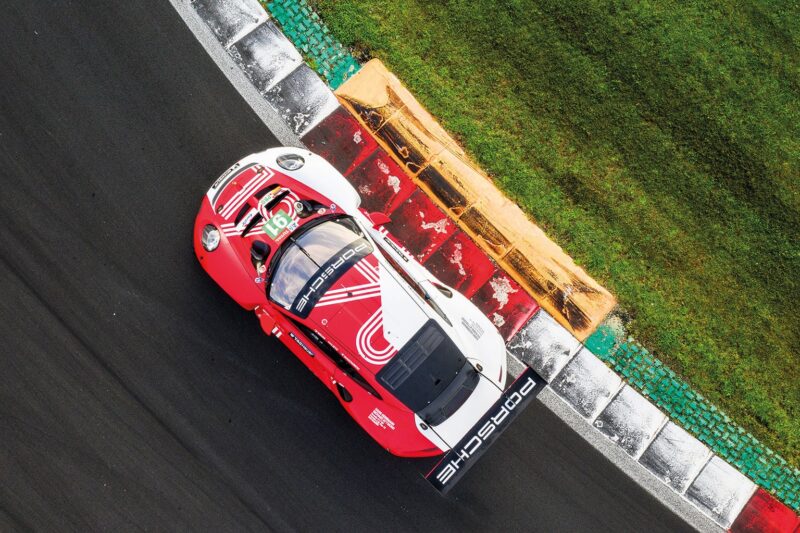
It looks like a street car, but looks can be very deceiving…
There’s also that other thing that we who track test cars don’t much like to talk about. This car is not being run by a mate out the back of a Transit. Today I have the Porsche WEC squad as my pitcrew. They come with gimlet eyes and banks of computers out the back. You don’t want to mess up in front of them. By that I don’t mean stick it in the wall because that’s unthinkable, but you have to find the balance between not driving so hard you run out of talent, dump it in the gravel and never get asked back and driving so slowly they wonder why you bothered to get on the plane.
“Don’t worry, it’s easy,” says Gimmi Bruni as he leans into the cockpit. “Don’t be scared to push, the car is fantastic, lots of downforce…”
Always start in gear, feet on brake and clutch, press buttons either side of the wheel and with a bang the RSR-19 wakes up. It might be the loudest car I’ve ever driven. The clutch is heavy but gentle so at least I don’t stall it. I’ve got two laps, then a chat, then four laps and then four more at Porsche’s discretion, depending on how I’ve done so far. And after the first two it’s not looking good. The car doesn’t feel trustworthy, understeers too much on entry and relies too much on the traction control (set by Gimmi, which I’m not allowed to touch) at the exit. It feels ragged. The brake pedal is also disconcertingly long.
I come back in wearing my brave face and try not to sound like a graceless arse criticising the set up of a car that’s good enough for a man who has won his class at Le Mans three times.
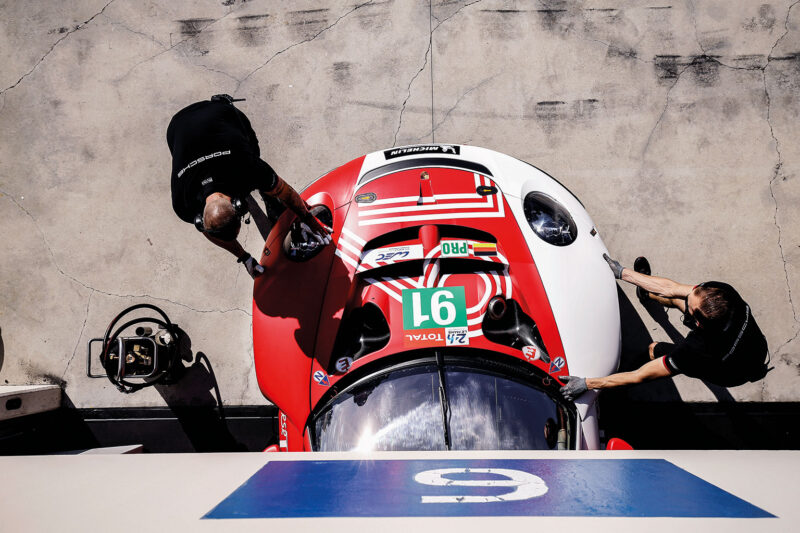
It’s a rare delight to have the Porsche WEC squad as your crew
Happily, they ignore me. “Okay,” I am told. “You can go again.” But those few stationary moments were enough for my brain to study the data it had absorbed on those opening laps and now I drive more fluently. This in turn gets me into the virtuous circle where I am able to get the tyres and brakes into their operating windows, and suddenly the RSR feels like a different car. The power band is quite narrow, as you’d expect given that the engine lacks turbochargers, but so long as you wait for the change up lights to turn blue you’re always in the thick of it. Unlike most rivals, Porsche doesn’t use a proprietary gearbox but designs its own and I’m not sure I’ve ever pulled a smoother shift in a racing car. Engineers of high-performance road cars usually program in a slight jolt as the power is taken up again just to make the feel more sporting. With the RSR the reverse is the case.
The track is starting to flow now even though I’m aware of how restrictive it is for a car like this. However good it is at Vallelunga, somewhere like Silverstone or Spa would be another world. In slow corners the RSR feels caged. The A-pillar is thick so spotting the apex of left handers is hard and you find yourself using far more steering lock than anticipated. Grip levels are actually not that remarkable.
But give that bodywork and diffuser even a sniff of the action – and you’ll feel the effect even in second-gear turns – and a whole new world awaits. The brakes may not be carbon but are still befuddling. Just out of interest I try to see if I can get the ‘impending lock-up’ lights to twinkle on the dashboard at whatever speed it will do in top gear, so probably the far side of 170mph. Not a flicker. Until you’ve shed enough speed and therefore downforce, it just feels like you’ve driven into a vat of treacle. And by the time that’s happened you’re way past the entry point to the corner and easing off the brakes as you angle into the apex.
And that’s where it feels most otherworldly. Whereas the GT3 cars I’ve driven have felt like binary devices, effective but brutal and in need of much manhandling, I am certain that the only thing in the sports car world that could be more sophisticated than this would be a pure prototype. The lack of pitch and its ability to maintain ride height on entry is not so much confidence-enhancing as awe-inspiring.
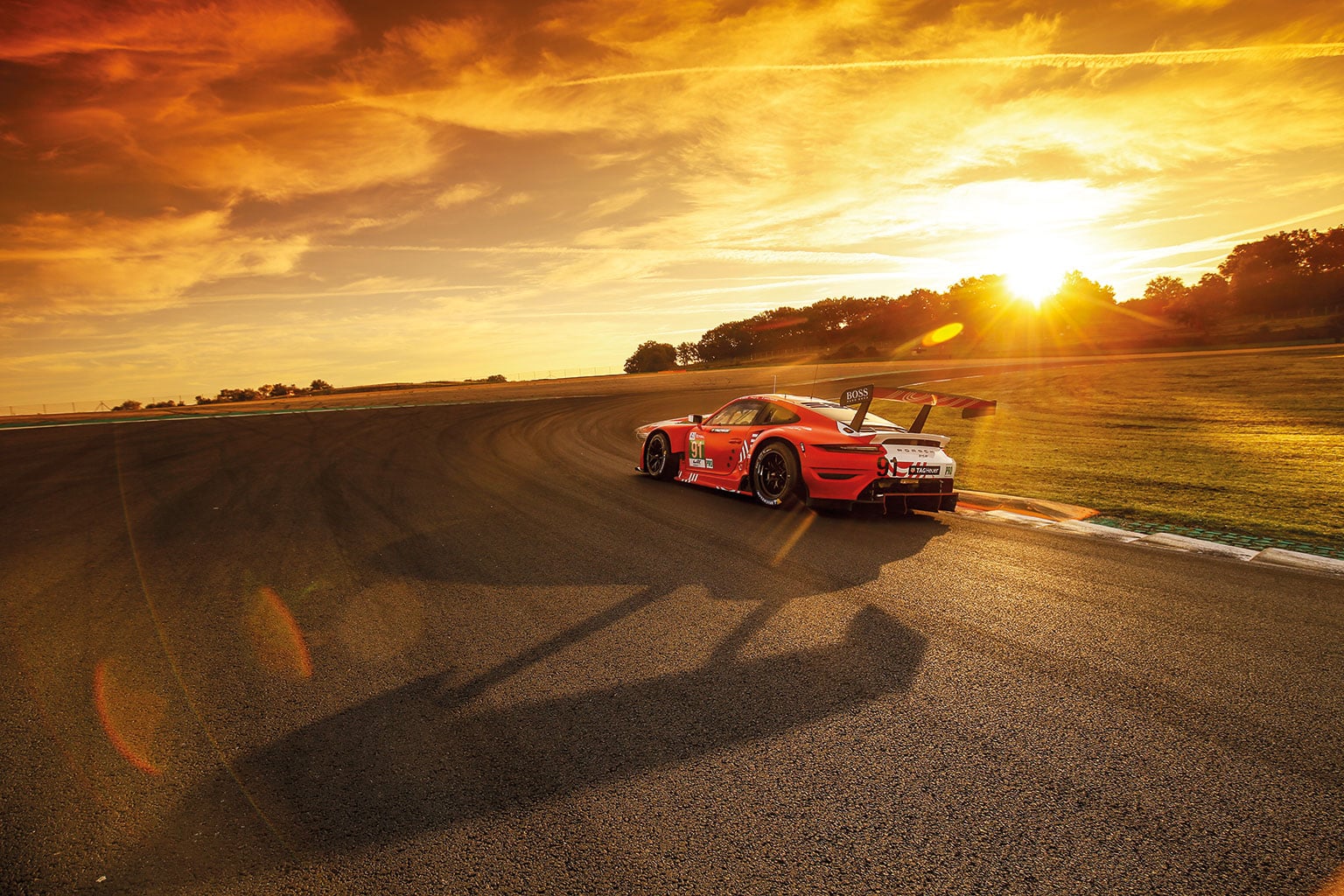
I got my extra laps and now, fully dialled into the RSR (if not the circuit) and finally taking Gimmi at his word, I was treated to the most devastating display of pure ability I have experienced from a car related – however distantly – to something intended for road use.
Until I drove the RSR, I had wondered why it and other GTE cars are so much faster than GT3 machines, despite similar power and weight. In America where they race together under IMSA regs, the difference between the RSR-19 and Porsche’s 911 GT3R is usually around 3sec a lap, which is a chunky gap, rising to over 5sec at a really rapid circuit like Road America. I wonder no more: their chassis and aero sophistication are in a different league.
And yet. About a year ago I drove a Porsche 911 Cup car, which is the entry level to works-developed Porsche 911 racing cars. Despite having only 30 fewer horsepower and weighing around 50kg less, it costs less than a fifth of the price of the RSR. Drive it and you see why: there’s little aero there and no driver aids. It doesn’t try to make life easy, it tries to make
it hard. It’s all down to you, and I like that.
If I had Gimmi’s experience I’d tax the RSR-19 to the limit and find whole dimensions of challenge you could not hope to experience in a few laps on a strange track. At my level the RSR provided a technical demonstration I was fortunate to be able to see, whereas in the Cup car I felt I was participating.
Even so, when I go to Le Mans I’ll do so with a new respect for the GT class cars and the RSR-19 in particular. Is it a 911? I’m not sure. Is it the most impressive car to look like a street machine that I’ve ever driven? By a mile.
Specification
Price: £860,000
Power: 515bhp
Torque: 347lb ft
Engine: Rear mid-mounted 4.2-litre flat six
Gearbox: Six-speed semi-automatic paddle-shift
Weight: 1245kg
Max speed (Le mans): 186mph
